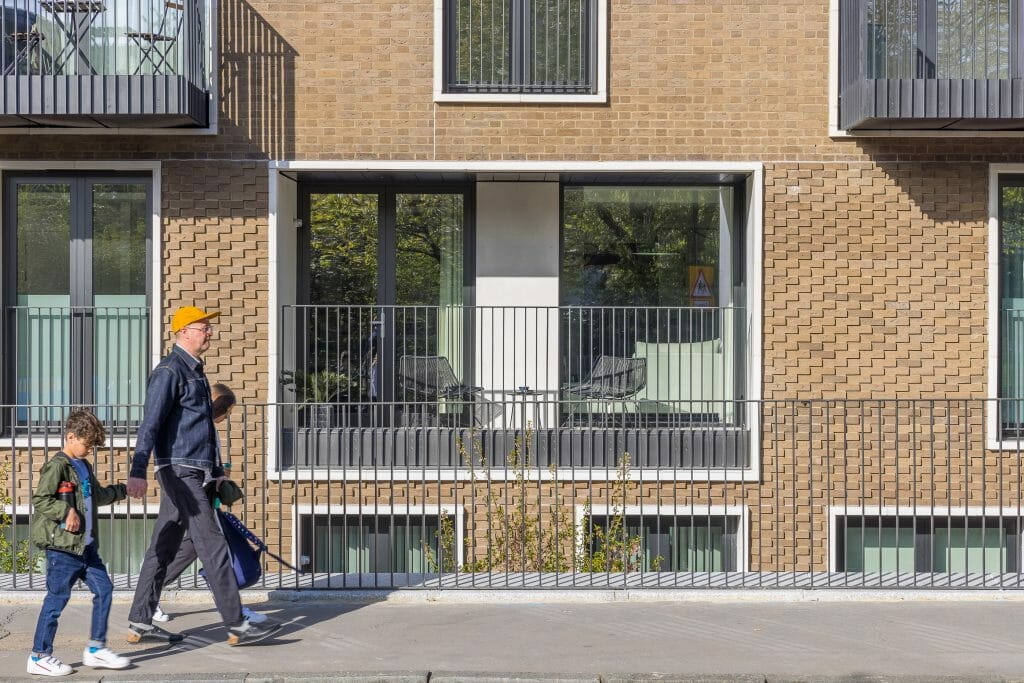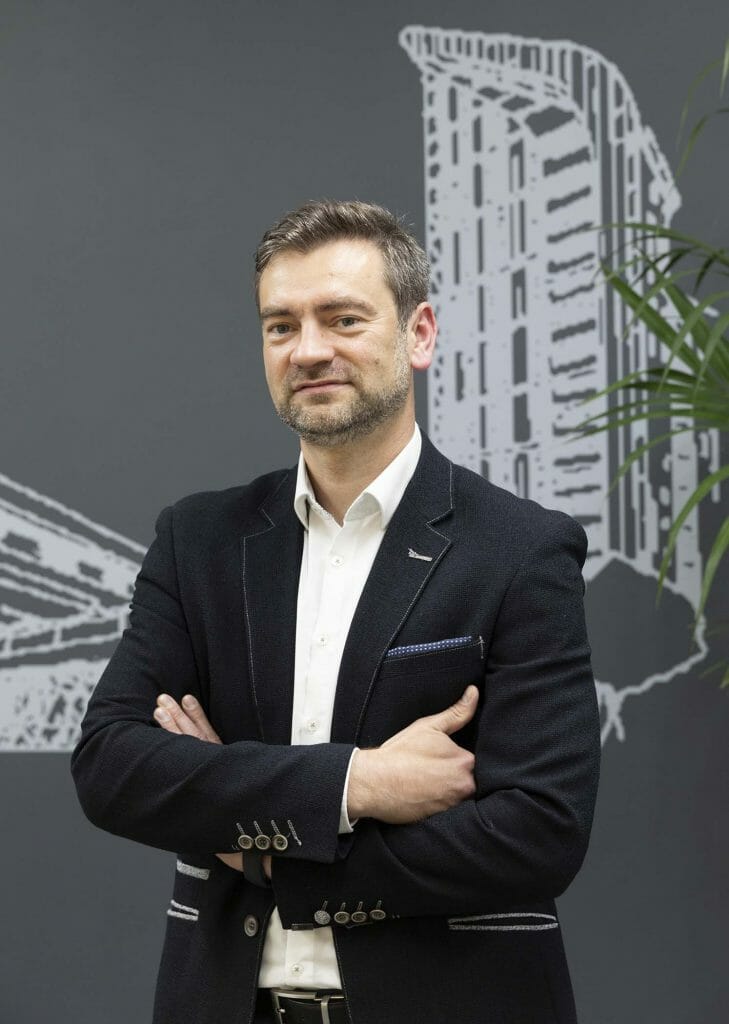
By Wojciech Brozyna – MD of Aluprof UK
Powder Coating continues to be specified as just a colour. Whilst this approach works well in many instances, especially where there is a substantial supply chain, there are instances where coatings may be applied incorrectly. If a robust specification is not in place, this could cause issues with the finish in a few years after installation.
Architectural powder coating is a two-step process, the cleaning and pretreatment of the aluminium and then the powder coating itself. Only when both processes are correctly specified and completed, with suitably sourced materials for the location of the project, can the project be deemed to offer a sustainable powder coating solution.
Projects often carry not just extrusions but preformed sheet pressings cills, preformed column casings and often aluminium sheet used in composite spandrel panels. These are often powder coated in different locations which can introduce shading issues between batches, or indeed manufacturers of different powders. To further complicate matters, should aluminium castings need to be coated, these may be coated in a further coating facility. The key to success is to discuss the finishes of various suppliers of materials and agree a common specification.
Quality control can be achieved by recognising what variations in finish might be acceptable by agreeing up front both the colour variance and gloss variance on the proposed finish. The main issue is that being prepared for potential colour variation means that this could be potentially controlled to a degree to minimise its effect.
The main parts of any powder coating specification should contain, details of the pretreatment system to be used, the colour specification, the gloss level and the class of powder to be used. If there are to be parts of the facade that are going to be coated in different plants, such as the addition of aluminium pressings or spandrel panels, the manufacturer of the powder would help further minimise colour variation.
Aluprof are licence holders of QUALICOAT, a globally recognised standard for powder coating procedure and quality. This association recognises the need for quality of the pretreatment systems, the architectural powder colours and the application quality. The association therefore licences both producers of the powders, the pretreatment systems and applicators to ensure that quality levels are attained and maintained. Regular inspections of QUALICOAT licence holders are undertaken by third party test houses. This is a crucial cornerstone of membership of QUALICOAT and something that Aluprof are proud to offer on all specifications.
So, starting with the pretreatment specification, sometimes referred to as a conversion coating of the aluminium, either a chrome free or chrome-based system can be used for most locations. The main aim of this pretreatment is to completely seal the aluminium substrate to stop oxidisation and also to provide a key for the powder to adhere too. Alternatively, a thin anodised finish can be used prior to powder coating which offers a more robust pretreatment. There are also variations of pretreatment options when it comes to specifying projects near the coast when a ‘Seaside’ class of pretreatment can be used which incorporates a longer or deeper aluminium etch process in its application to remove aluminium substrate contaminants.
Whilst a colour specification may seem fixed, there are variances that need to be considered. Different powder manufacturers of the same RAL colour could vary in shade, indeed, even using the same powder manufacturer with different batches of powder there can be a very slight shading difference. The key here is to agree an upper and lower shading specification, if appropriate, or better still try to specify the powder manufacturer to minimise any colour variance if products are to be produced in different powder coating applicators.
In addition to colour there are a range of gloss levels available, these are generally referred to as, ‘matt’, with a 20% and 30% gloss level, ‘semi-gloss’, having approximately 60-65% gloss level and ‘full gloss’ with 80% gloss level. As with colours, gloss levels across powder manufacturers vary so care should be taken to agree upper and lower limits so that when the products are placed together there is very little variation.
Powders also come in various grades, all offer a long-life expectancy, but higher grades, or classes of powder offer greater colour fastness when subject to UV light and better gloss retention. Gloss can be lost as a result of airborne abrasion as well as UV degradation. Typically, we see Class 1 powders used in the UK with some high rise and prestigious projects opting for more resilient Class 2 powders. Class 3 powders are generally not used in the UK and are specified in harsher environments such as in the equatorial regions.
Powder coating can also be specified to accurately replicate anodised finishes. This option is more cost effective than anodising and offers a consistent shade across all profiles. Powder coating can also be supplied using a sublimation process which offers wood grain, stone or concrete effects, in fact virtually any texture can be created. The sublimation process is covered by a QUALIDECO licence which is part of the QUALICOAT label for special finishing.
So, the answer certainly is a yes, on any project, the architectural powder coating needs to be specified clearly, not only for the visual aspect of the finish looking correct, but for the finishes ability to offer a long and sustainable life. Aluminium surface pretreatment or conversion coatings are crucial to this long-life expectancy. It is important to note that all powder coatings are porous and do let air and water vapour permeate through them, if a pretreatment process is poor or worse nonexistent, in time the aluminium substrate will oxidise and the powder coating will simply flake off.
As a specifier, it is important to take advice, especially when powder coated items are being source from different manufacturers and suppliers. At Aluprof all our architectural advisors are experienced in both powder coating and anodised finishes so are able to advise on the correct specification. By being aware of the potential issues that could be raised on what is the most visible aspect of an aluminium facade, the finish specification is crucial to a project being completed on time and in the right quality.
On a final point, it has been proven that not all aluminium composition is the same, especially as we begin to use more recycled content in our aluminium extrusions and this can effect the long term stability of the substrate. Trace and tramp elements present in alloys need to be carefully monitored as these can have an effect on the sustainability of the final coating. Fortunately, with today’s modern and accurate spectrometers the materials present in any alloy can be determined as well as the percentage of each material’s occurrence in the alloy as every type of alloy element has its own colour. Aluprof have very tight specifications as to what is acceptable in the bulk billet prior to extrusion to maximise a powder coated products life expectancy.
Since setting up the Aluprof Office at the Business Design Centre in London, the company has rapidly grown their specification influence in the UK with their high-performance architectural aluminium systems. Further expansion of the company’s headquarters in Altrincham now provides specifiers with meeting facilities and an extensive showroom of commercial systems to view. With overseas growth across Europe spreading into the Middle East and firm roots already in the East of the USA, the company is becoming a global player in facade supply.
Further information is available on the company’s website at aluprof.co.uk or direct from their UK head office in Altrincham on 0161 941 4005.




